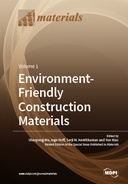Explore

Environment-Friendly Construction Materials
0 Ungluers have
Faved this Work
Login to Fave
Construction materials are the most widely used materials for civil infrastructure in our daily lives. However, from an environmental point of view, they consume a huge amount of natural resources and generate the majority of greenhouse gasses. Therefore, many new and novel technologies for designing environmentally friendly construction materials have been developed recently. This Special Issue, “Environment-Friendly Construction Materials”, has been proposed and organized as a means to present recent developments in the field of construction materials. It covers a wide range of selected topics on construction materials.
This book is included in DOAB.
Why read this book? Have your say.
You must be logged in to comment.
Rights Information
Are you the author or publisher of this work? If so, you can claim it as yours by registering as an Unglue.it rights holder.Downloads
This work has been downloaded 342 times via unglue.it ebook links.
- 73 - pdf (CC BY-NC-ND) at Unglue.it.
- 172 - pdf (CC BY-NC-ND) at res.mdpi.com.
Keywords
- adhesion energy
- adsorption
- aged asphalt
- aged bitumen
- ageing
- ageing resistance
- aggregate characteristics
- aggregate from sanitary ceramic wastes
- aggregate image measurement system
- aggregate morphology
- aggregates
- aging depth
- aging processes
- aluminum hydroxide
- amorphous silica
- anti-rutting agent
- aqueous solute compositions
- artificial neural network
- artificially aged asphalt mixture
- asphalt
- asphalt combustion
- asphalt mastic
- asphalt mixes
- asphalt mixture
- asphalt mortar
- asphalt pavement
- asphalt-aggregate adhesion
- basalt fiber
- bio-oil
- bitumen
- building energy conservation
- building envelopes
- Ca-alginate microcapsules
- calcium alginate capsules
- carbonation
- Cement
- cement emulsified asphalt mixture
- chemical evolutions
- CO2
- cold recycled asphalt mixture
- colloidal structure
- combination
- compound modify
- Concrete
- construction materials
- contact angle
- crack healing
- Creep
- crumb rubber
- crumb rubber powder
- crystallization sensitivity
- damage characteristics
- damage constitutive model
- damage evolution
- damping
- demulsification speed
- design optimization
- desulphurization gypsum residues
- Diatomite
- diatomite-modified asphalt mixture
- diffusing
- dissipated strain energy
- durability
- dynamic characteristics
- dynamic moduli
- dynamic responses
- dynamic tests
- effective heating depth
- emulsified asphalt
- energy-based approach
- engineered cementitious composites (ECC)
- environmentally friendly construction materials
- epoxidized soybean oil
- expanded graphite
- fatigue equation
- fatigue life
- fatigue performance
- fatigue property
- fiber modification
- field evaluation
- flame retardant
- flexibility
- flow behavior index
- fluidity
- fluorescence spectrum
- freeze-thaw cycle
- granite aggregate
- Graphene
- healing agents
- healing model
- high-modulus asphalt mixture (HMAM)
- high-strength concrete
- History of engineering & technology
- hot mix asphalt containing recycled concrete aggregate
- hydration characteristic
- hydrophilic nanosilica
- hydrophobic nanosilica
- induced healing
- induction heating
- initial self-healing temperature
- interfacial transition zone
- laboratory evaluation
- layered double hydroxide
- limestone
- limestone aggregates
- long-term drying shrinkage
- long-term field service
- low-temperature
- mastic
- MDA
- mechanical behavior
- micro-morphology
- micro-surfacing
- microfluidic
- Microstructure
- microwave heating
- mineral-asphalt mixtures
- modified asphalt materials
- molecular bridge
- molecular dynamic simulation
- Morphology
- nanomaterial
- nitrogen and phosphorus removal
- optimization
- overlay tester
- parametrization
- pavement failure
- pavement performance
- permeation
- phase change materials
- physical properties
- plant ash lixivium
- plateau value of dissipated strain energy ratio
- plateau value of permanent deformation ratio
- polyacrylic acid
- polyethylene glycol
- Polyvinyl Alcohol
- porous pumice
- pozzolanic reaction
- railway application
- rankinite
- reclaimed asphalt pavement
- recycled material
- recycling
- recycling aggregate
- Regeneration
- rejuvenating systems
- Rejuvenation
- rejuvenator
- relaxation
- resistance to deformations
- response surface methodology
- rheological properties
- rheology
- rice husk ash
- road engineering
- rubber modified asphalt
- rutting factor
- sanitary ceramics
- SBS-modified bitumen
- SBS/CRP-modified bitumen
- self-compacting concrete (SCC)
- Self-healing
- self-healing asphalt
- SEM
- sensitivity analysis
- sequencing batch Chlorella reactor
- simplex lattice design
- skid-resistance
- SOD
- solubilizer
- specific surface area
- steel fiber
- steel slag
- stripping test
- styrene–butadiene–styrene (SBS) modified bitumen
- surface energy
- surface texture
- Technology, engineering, agriculture
- Technology: general issues
- temperature sensitivity characteristics
- tensile strains
- tensile stresses
- thermal property
- thermal–mechanical properties
- thickness combinations
- three-point bending fatigue test
- titanate coupling agent
- transmittance
- ultra-high performance concrete
- Ultra-High Performance Concrete (UHPC)
- ultra-thin wearing course
- Ultraviolet radiation
- vibration noise consumption
- viscoelastic properties
- viscoelasticity
- viscous-elastic temperature
- waste concrete
- water solute exposure
- water stability
- water-leaching pretreatment
- workability
- X-ray computed tomography
- “blue-shift”
Links
DOI: 10.3390/books978-3-03921-013-8Editions


